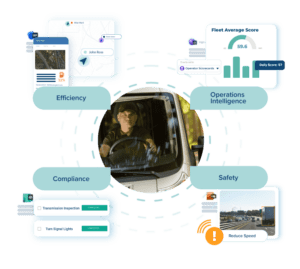When you’re responsible for the efficient operations of a growing fleet, figuring out how to get more done in less time is critical.
Time really is your scarcest resource.
The good news? There are steps you can take today to reclaim hours in your work week. The solution is to automate fleet activities. You need to streamline work processes of the tasks and reports you regularly repeat. When you cut the inefficiencies out of those processes, you’ll save countless hours. That gives you more time to focus on activities that improve the bottom line of your business.

The Time-Saving Benefits of Automating Fleet Operations
Every minute you spend chasing down the information you need:
- Calculating fuel costs or mileage so you can accurately bid a new job
- Scrambling to put a contingency plan in place because of unexpected vehicle downtime
- Sifting through hours of dash cam video to find the few frames that will exonerate your driver
Is time not spent making your business more agile, profitable or customer-centric.
We’ve talked to hundreds of fleet safety and operations managers, and have identified 5 best practices you can put to work in your business today. Automating fleet operations gives you more time to focus on your business instead of your fleet:
1. Proactively Track Asset Status and Location
When you count on your vehicles to service specific routes and customers each day, unexpected events can derail your schedule without warning:
- An asset breaks down in the middle of a route
- A vehicle isn’t available in the location you’d planned,
- A customer schedule change leaves you scrambling to accommodate a new destination
These are just a few things that can throw your day off balance.
To avoid this productivity-killing cycle, digitize and automate your inspections, maintenance reporting and asset tracking. This assures that critical inspection and maintenance protocols are consistently followed, and that small issues are identified and resolved before they lead to downtime – and real-time reporting ensures that you stay in the loop.

2. Leverage Real-Time Alerts and Notifications
Take full advantage of the capabilities that come with automating fleet activities. Set up event thresholds and configure alerts that are critical to your business. These automated flags ensure you’re the first to know when an incident occurs – giving you the opportunity to take quick action to keep your fleet running.
The initial time invested in setting up these alerts pays huge dividends in time saved. You’ll no longer waste time manually checking – and rechecking – the status of assets, operators and projects.
3. Automate Time-Consuming Processes
Take time to identify the processes and reports that you repeat on a daily, weekly, or even monthly basis. Prioritize those that currently demand daily attention. The goal is to drive the information to you, versus manually seeking it out.
Targets can include compliance reporting, safety incidents, preventative maintenance status, fuel use and driver safety scores.

4. Enable Cross-Departmental Data Sharing for Fast, Effective Decisions
To optimize efficiency, and profitably grow the business, you can’t go it alone. But as a business grows, you’re likely to find yourself struggling with a string of point solutions that were deployed as your tech stack was built over time. In the beginning, each solved a specific problem and eased the growing pain – for a while.
But they don’t talk to each other. Data from your safety program is separate from your telematics or your fuel management. You can’t see the correlations or do root-cause analysis to improve performance and cut costs, without a lot of manual data integration. Work across your team to define business requirements and standardize on a single platform. You’ll increase adoption, stop wasting time switching between systems, and have all of your data accessible and shareable from a single interface.
5. Maximize safety and minimize the time it takes to hit safety metrics
Safety is at the heart of every fleet manager’s responsibility. Keeping drivers and operators safe, and achieving company-wide safety goals, also protects your business from expensive – sometimes crippling – insurance claim and legal payouts. Safety improvements also the cut the time-consuming processes and reports you deal with when an incident occurs.
First, implement operator scorecards. Your drivers are likely to perform at higher levels when they have clear goals and know how they’re measured. One way to automate performance improvements is through gamification. Build a reward program and leaderboard to encourage friendly competition that helps you hit your goals.
Ready to take it to the next level? The proactive alerting and in-cab coaching that comes with AI-powered dash cams is like an extension of your staff resources. And the timestamped, on-demand incident video puts an end to manually scrolling through hours of video to find the few frames that exonerate your driver.
But not all solutions are created equal. Your users want a modern, yet simple and approachable solution. At the same time, it must be powerful enough to support advanced AI and integrations that, over time, provide massive improvements in operations and employee safety.


